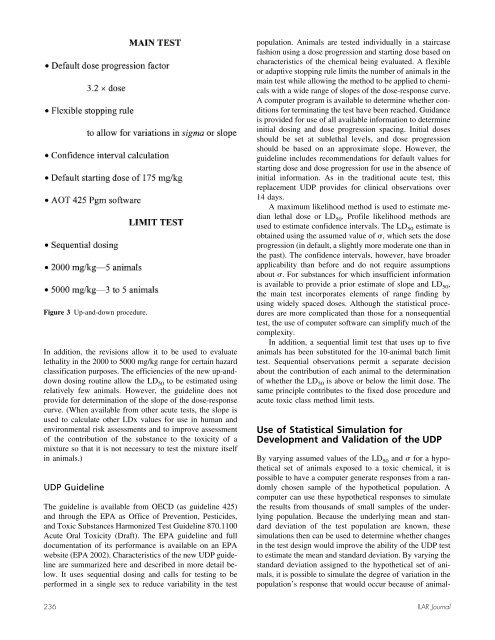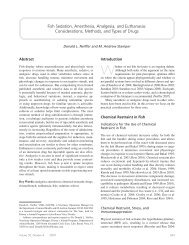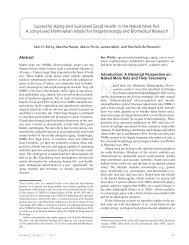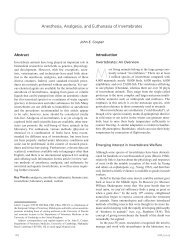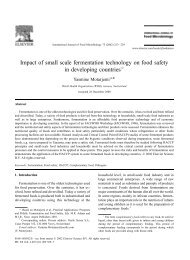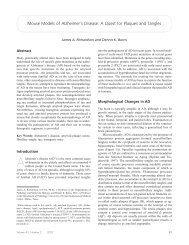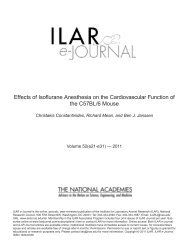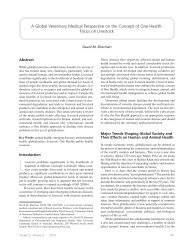Alternative Methods for the Median Lethal Dose (LD50) Test: The Up ...
Alternative Methods for the Median Lethal Dose (LD50) Test: The Up ...
Alternative Methods for the Median Lethal Dose (LD50) Test: The Up ...
You also want an ePaper? Increase the reach of your titles
YUMPU automatically turns print PDFs into web optimized ePapers that Google loves.
Figure 3 <strong>Up</strong>-and-down procedure.<br />
In addition, <strong>the</strong> revisions allow it to be used to evaluate<br />
lethality in <strong>the</strong> 2000 to 5000 mg/kg range <strong>for</strong> certain hazard<br />
classification purposes. <strong>The</strong> efficiencies of <strong>the</strong> new up-anddown<br />
dosing routine allow <strong>the</strong> LD 50 to be estimated using<br />
relatively few animals. However, <strong>the</strong> guideline does not<br />
provide <strong>for</strong> determination of <strong>the</strong> slope of <strong>the</strong> dose-response<br />
curve. (When available from o<strong>the</strong>r acute tests, <strong>the</strong> slope is<br />
used to calculate o<strong>the</strong>r LDx values <strong>for</strong> use in human and<br />
environmental risk assessments and to improve assessment<br />
of <strong>the</strong> contribution of <strong>the</strong> substance to <strong>the</strong> toxicity of a<br />
mixture so that it is not necessary to test <strong>the</strong> mixture itself<br />
in animals.)<br />
UDP Guideline<br />
<strong>The</strong> guideline is available from OECD (as guideline 425)<br />
and through <strong>the</strong> EPA as Office of Prevention, Pesticides,<br />
and Toxic Substances Harmonized <strong>Test</strong> Guideline 870.1100<br />
Acute Oral Toxicity (Draft). <strong>The</strong> EPA guideline and full<br />
documentation of its per<strong>for</strong>mance is available on an EPA<br />
website (EPA 2002). Characteristics of <strong>the</strong> new UDP guideline<br />
are summarized here and described in more detail below.<br />
It uses sequential dosing and calls <strong>for</strong> testing to be<br />
per<strong>for</strong>med in a single sex to reduce variability in <strong>the</strong> test<br />
population. Animals are tested individually in a staircase<br />
fashion using a dose progression and starting dose based on<br />
characteristics of <strong>the</strong> chemical being evaluated. A flexible<br />
or adaptive stopping rule limits <strong>the</strong> number of animals in <strong>the</strong><br />
main test while allowing <strong>the</strong> method to be applied to chemicals<br />
with a wide range of slopes of <strong>the</strong> dose-response curve.<br />
A computer program is available to determine whe<strong>the</strong>r conditions<br />
<strong>for</strong> terminating <strong>the</strong> test have been reached. Guidance<br />
is provided <strong>for</strong> use of all available in<strong>for</strong>mation to determine<br />
initial dosing and dose progression spacing. Initial doses<br />
should be set at sublethal levels, and dose progression<br />
should be based on an approximate slope. However, <strong>the</strong><br />
guideline includes recommendations <strong>for</strong> default values <strong>for</strong><br />
starting dose and dose progression <strong>for</strong> use in <strong>the</strong> absence of<br />
initial in<strong>for</strong>mation. As in <strong>the</strong> traditional acute test, this<br />
replacement UDP provides <strong>for</strong> clinical observations over<br />
14 days.<br />
A maximum likelihood method is used to estimate median<br />
lethal dose or LD 50. Profile likelihood methods are<br />
used to estimate confidence intervals. <strong>The</strong> LD 50 estimate is<br />
obtained using <strong>the</strong> assumed value of , which sets <strong>the</strong> dose<br />
progression (in default, a slightly more moderate one than in<br />
<strong>the</strong> past). <strong>The</strong> confidence intervals, however, have broader<br />
applicability than be<strong>for</strong>e and do not require assumptions<br />
about . For substances <strong>for</strong> which insufficient in<strong>for</strong>mation<br />
is available to provide a prior estimate of slope and LD 50,<br />
<strong>the</strong> main test incorporates elements of range finding by<br />
using widely spaced doses. Although <strong>the</strong> statistical procedures<br />
are more complicated than those <strong>for</strong> a nonsequential<br />
test, <strong>the</strong> use of computer software can simplify much of <strong>the</strong><br />
complexity.<br />
In addition, a sequential limit test that uses up to five<br />
animals has been substituted <strong>for</strong> <strong>the</strong> 10-animal batch limit<br />
test. Sequential observations permit a separate decision<br />
about <strong>the</strong> contribution of each animal to <strong>the</strong> determination<br />
of whe<strong>the</strong>r <strong>the</strong> LD 50 is above or below <strong>the</strong> limit dose. <strong>The</strong><br />
same principle contributes to <strong>the</strong> fixed dose procedure and<br />
acute toxic class method limit tests.<br />
Use of Statistical Simulation <strong>for</strong><br />
Development and Validation of <strong>the</strong> UDP<br />
By varying assumed values of <strong>the</strong> LD 50 and <strong>for</strong> a hypo<strong>the</strong>tical<br />
set of animals exposed to a toxic chemical, it is<br />
possible to have a computer generate responses from a randomly<br />
chosen sample of <strong>the</strong> hypo<strong>the</strong>tical population. A<br />
computer can use <strong>the</strong>se hypo<strong>the</strong>tical responses to simulate<br />
<strong>the</strong> results from thousands of small samples of <strong>the</strong> underlying<br />
population. Because <strong>the</strong> underlying mean and standard<br />
deviation of <strong>the</strong> test population are known, <strong>the</strong>se<br />
simulations <strong>the</strong>n can be used to determine whe<strong>the</strong>r changes<br />
in <strong>the</strong> test design would improve <strong>the</strong> ability of <strong>the</strong> UDP test<br />
to estimate <strong>the</strong> mean and standard deviation. By varying <strong>the</strong><br />
standard deviation assigned to <strong>the</strong> hypo<strong>the</strong>tical set of animals,<br />
it is possible to simulate <strong>the</strong> degree of variation in <strong>the</strong><br />
population’s response that would occur because of animal-<br />
236 ILAR Journal


